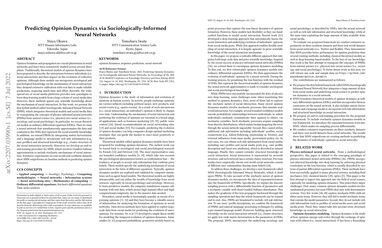Predicting Opinion Dynamics via Sociologically-Informed Neural Networks
Opinion formation and propagation are crucial phenomena in social networks and have been extensively studied across several disciplines. Traditionally, theoretical models of opinion dynamics have been proposed to describe the interactions between individuals (i.e., social interaction) and their impact on the evolution of collective opinions. Although these models can incorporate sociological and psychological knowledge on the mechanisms of social interaction, they demand extensive calibration with real data to make reliable predictions, requiring much time and effort. Recently, the widespread use of social media platforms provides new paradigms to learn deep learning models from a large volume of social media data. However, these methods ignore any scientific knowledge about the mechanism of social interaction. In this work, we present the first hybrid method called Sociologically-Informed Neural Network (SINN), which integrates theoretical models and social media data by transporting the concepts of physics-informed neural networks (PINNs) from natural science (i.e., physics) into social science (i.e., sociology and social psychology). In particular, we recast theoretical models as ordinary differential equations (ODEs). Then we train a neural network that simultaneously approximates the data and conforms to the ODEs that represent the social scientific knowledge. In addition, we extend PINNs by integrating matrix factorization and a language model to incorporate rich side information (e.g., user profiles) and structural knowledge (e.g., cluster structure of the social interaction network). Moreover, we develop an end-to-end training procedure for SINN, which involves Gumbel-Softmax approximation to include stochastic mechanisms of social interaction. Extensive experiments on real-world and synthetic datasets show SINN outperforms six baseline methods in predicting opinion dynamics.
PDF Abstract


